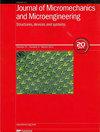将 SU-8 和高度纠缠的聚丙烯酰胺水凝胶进行异构微架构整合,实现耐切割的软性超疏水表面
IF 2.1
4区 工程技术
Q2 ENGINEERING, ELECTRICAL & ELECTRONIC
引用次数: 0
摘要
本文提出了一个新颖的想法,即通过在高度纠缠的聚丙烯酰胺(PAAm)水凝胶基底上集成 SU-8 微柱阵列来制造抗切割的超疏水(SHPo)表面。我们首先证明了这种高度纠缠的 PAAm 水凝胶具有卓越的抗切割性,同时与聚二甲基硅氧烷 (PDMS) 等其他聚合物基底一样透明、柔韧和可拉伸。目前,还没有众所周知的方法或化学品能直接将 SU-8 和 PAAm 以共价键结合在一起。为了克服这一难题,我们在 SU-8 和 PAAm 之间引入了一层化学修饰过的 PDMS 薄层,这样就能在 SU-8/PDMS 界面和 PDMS/PAAm 界面之间形成共价键。在实验中验证了键合的可靠性后,我们开发了一种异质集成工艺来制造所需的 SHPo 表面。为了证明 PAAm 水凝胶在实现耐切割 SHPo 表面中的关键作用,我们将这种新型 SHPo 表面与使用 PDMS 基底的参考版本进行了对比。在切割这两种表面前后,我们使用扫描电子显微镜和接触角测角仪进行了显微检查。这些评估结果表明,这两种表面在结构完整性和与水相互作用的行为方面存在显著差异。本文章由计算机程序翻译,如有差异,请以英文原文为准。
Heterogeneous micro-architectonic integration of SU-8 and highly entangled polyacrylamide hydrogel to realize cut-resistant soft superhydrophobic surfaces
This paper presents a novel idea to create cut-resistant superhydrophobic (SHPo) surfaces by integrating an array of SU-8 micropillars on a highly entangled polyacrylamide (PAAm) hydrogel substrate. We begin by demonstrating that this highly entangled PAAm hydrogel exhibits superior resistance to cutting while being as transparent, flexible, and stretchable as other polymeric substrates like polydimethylsiloxane (PDMS). Currently, there are no well-known methods or chemicals to directly integrate SU-8 and PAAm with a covalent bond. To overcome this challenge, we introduce a thin layer of chemically modified PDMS between the SU-8 and PAAm so that covalent bonds can be formed between both the SU-8/PDMS interface and the PDMS/PAAm interface. After validating the reliability of the bonding in our experiments, we develop a heterogeneous integration process to fabricate the desired SHPo surface. To demonstrate the critical role of PAAm hydrogel in achieving the cut-resistant SHPo surface, we contrast this new SHPo surface with a reference version that uses a PDMS substrate instead. We conduct microscopic inspections using scanning electron microscopy and a contact angle goniometer before and after cutting the two surfaces. These evaluations show significant differences in their structural integrity and behavior in water interaction.
求助全文
通过发布文献求助,成功后即可免费获取论文全文。
去求助
来源期刊

Journal of Micromechanics and Microengineering
工程技术-材料科学:综合
CiteScore
4.50
自引率
4.30%
发文量
136
审稿时长
2.8 months
期刊介绍:
Journal of Micromechanics and Microengineering (JMM) primarily covers experimental work, however relevant modelling papers are considered where supported by experimental data.
The journal is focussed on all aspects of:
-nano- and micro- mechanical systems
-nano- and micro- electomechanical systems
-nano- and micro- electrical and mechatronic systems
-nano- and micro- engineering
-nano- and micro- scale science
Please note that we do not publish materials papers with no obvious application or link to nano- or micro-engineering.
Below are some examples of the topics that are included within the scope of the journal:
-MEMS and NEMS:
Including sensors, optical MEMS/NEMS, RF MEMS/NEMS, etc.
-Fabrication techniques and manufacturing:
Including micromachining, etching, lithography, deposition, patterning, self-assembly, 3d printing, inkjet printing.
-Packaging and Integration technologies.
-Materials, testing, and reliability.
-Micro- and nano-fluidics:
Including optofluidics, acoustofluidics, droplets, microreactors, organ-on-a-chip.
-Lab-on-a-chip and micro- and nano-total analysis systems.
-Biomedical systems and devices:
Including bio MEMS, biosensors, assays, organ-on-a-chip, drug delivery, cells, biointerfaces.
-Energy and power:
Including power MEMS/NEMS, energy harvesters, actuators, microbatteries.
-Electronics:
Including flexible electronics, wearable electronics, interface electronics.
-Optical systems.
-Robotics.
 求助内容:
求助内容: 应助结果提醒方式:
应助结果提醒方式:


